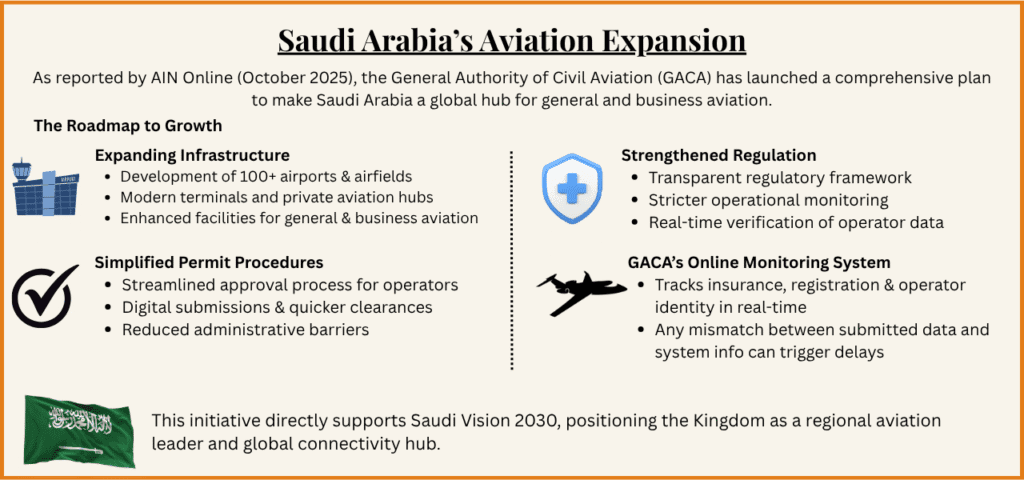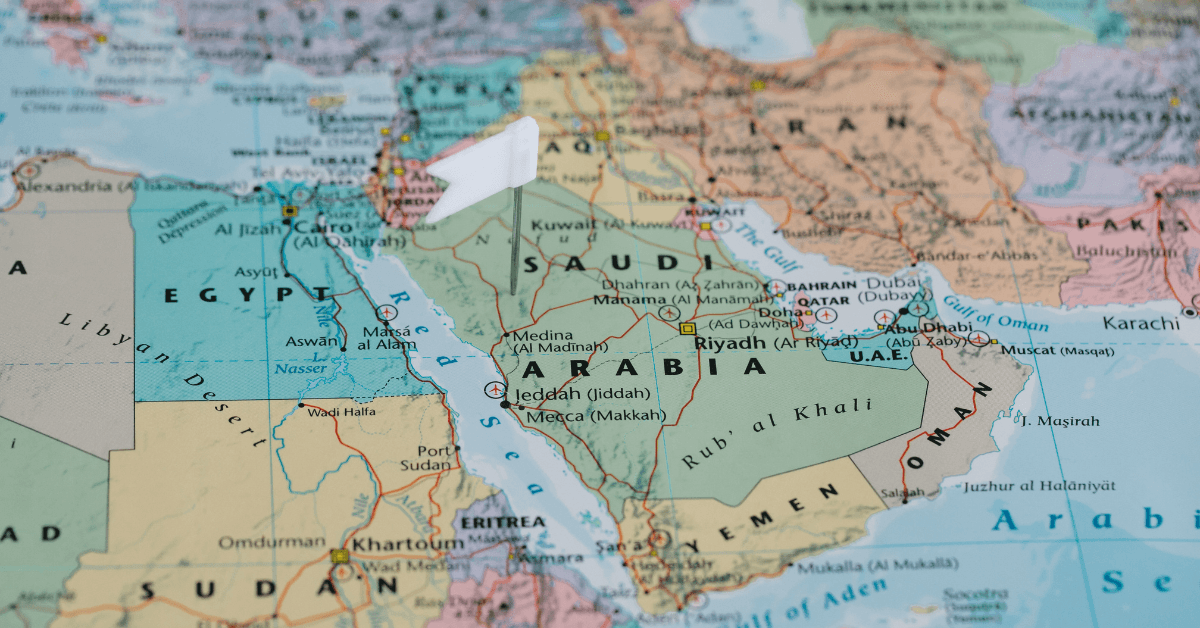All private aviation operations that enter or transit through the airspace of the Kingdom of Saudi Arabia have to have a valid approval or permit issued to them by the General Authority of Civil Aviation (GACA). The Kingdom requires two kinds of approvals or licenses to be obtained depending on the purpose of the flight:
- Overflight Permit (OVF): For planes transiting through the airspace.
- Landing Permit: Aircraft calling at or overflying the Kingdom for the purpose of fueling or crew rest.
Both documents can be obtained from GACA through approved local agents. Unlike other countries wherein interested applicants can submit their requests directly to the concerned authorities, the Kingdom of Saudi Arabia requires that requests be followed up from within the country. This is especially applicable to those who wish to operate sooner rather than later.
How to apply for a Saudi Arabia overflight permit
Even if no landing is to be made in Saudi Arabia, it is necessary to obtain the overflight permit if one intends to fly through the Saudi Flight Information Region (FIR). For instance, if a crew plans to fly to the Gulf or Asia or even the UAE from the USA, it is necessary to have an overflight permit.
Documentation required under GACA:
- Flight details: Entire route with Saudi FIR entry and exit points and purpose of flight.
- Certificate of Registration
- Certificate of Airworthiness
- Noise Certificate
- Certificate of Insurance (COI): Must include coverage for crew liabilities, passengers, third-party liability, baggage liabilities, hull-all risks coverage, and must include specifically the geographic area of the Kingdom of Saudi Arabia.
- Radio License: Must include both the Aircraft Registration Mark and the name of the operator.
- General Declaration: Crew and passenger list with nationality and passport information when asked.

Challenges and case example
GACA examines each submission carefully and at times verifies data against information in the GACA operator database. Incomplete or contradictory data may put requests on hold.
In a recent case we handled, a U.S.-registered plane asked for a permit to overfly in route to the UAE. A request for clarification came from the Saudi Civil Aviation Authority because of inadequate data on the radio license and the insurance documents. After the operator updated the files with information regarding the operator’s name and coverage of the Kingdom of Saudi Arabia, the permit was received on the same day.
This demonstrates how small discrepancies in documentation can bring processing to a standstill. While the processing of private (Part 91) overflights tends to be fairly quick, and usually accomplished within 24 hours, it is subject to closer review if there is missing information or if the plane record is not apparent in GACA’s database.
Landing permits
A private jet charter entering the Kingdom to land will require a landing permit. This will include business missions, private missions, diplomatic missions, or technical missions.
Information usually required:
- Purpose of flight and destination airport.
- Local handling agent or FBO confirmation letter.
- Duration of stay and parking needs.
- Information related to crew and passengers for visa and security arrangements.
- Aircraft documents mentioned above (aircraft registration, airworthiness certificate, noise certificate, insurance certificate, radio license).
Foreign-registered aircraft must have a local representative or handler. This ensures communication between the operator, the airports, and GACA. Without a representative or handler, the permit will not be released.
Landing permits are valid for dates and routes mentioned, and any modification regarding route or registration must be resubmitted. This takes a standard processing time ranging between 48 to 72 hours, which could be expedited depending on the availability of documents.
Submission process and timing
The working week at GACA is from Sunday to Thursday, with Friday and Saturday off for government offices. Requests made after working hours on Thursday will be considered on Sunday.
Typical timelines:
- Overflight permit: 24 hours (quicker if documents have been filed beforehand).
- Landing permit: 48–72 hours.
- Urgent flights: Case-by-case processing with designated Saudi agent.
Teams should also be aware of potential slowdowns during periods such as Hajj, Ramadan, or national holidays, due to increased commercial air traffic and administrative load.
How local agents engage with GACA
The Civil Aviation Authority of Saudi Arabia enters into formal agreements only with accredited local parties. These intermediaries act as the official link through which permit requests are submitted. After validation of documentation, approval codes are issued. The approval number is then communicated to the operator or trip support provider.
The Icarus Jet Trip Support team manages this process daily, ensuring that applications follow proper channels. This structure allows operations to be conducted efficiently, whether at short notice or under planned schedules.
Saudi Arabia’s aviation expansion
As reported by AIN Online in October 2025, the “roadmap to growth” proposed by the Saudi Arabian General Authority of Civil Aviation aims to improve accessibility to general and business aviation in the Kingdom. This initiative forms part of the national Vision 2030 goals.

GACA’s blueprint covers the development of more than one hundred airports and airfields, the overhaul of permit procedures, and improved infrastructure for private aviation. For operators, there is now a transparent regulatory framework paired with increased monitoring. GACA’s online system checks the insurance, registration, and identity of every aircraft operator in real time. Even a small discrepancy between submitted documents and portal information can cause delays.
Operational summary
The permit process in Saudi Arabia is procedural and predictable when followed correctly. For companies or pilots operating private jet charter flights, accuracy and timely coordination are essential for on-schedule approval. Overflight permits can be obtained in less than a day if documents are in order, whereas landing permits require more coordination with local agents.
Understanding these requirements allows dispatchers and crews to plan with precision across one of the most strategically positioned and tightly regulated airspaces in the Middle East.
FAQs
1. How early should overflight and landing permits be requested?
Overflight: At least 24 hours before entering the Saudi FIR.
Landing: 48 to 72 hours prior to arrival. Earlier submissions are advised during religious or peak travel periods.
2. Are private (Part 91) and charter (Part 135) operations handled differently?
Yes. Charter flights require additional verification such as an Air Operator Certificate and confirmed ground handling. Private flights are generally processed faster when documentation is complete.
3. What documentation errors cause delays?
Lack of operator information on the radio license, absence of Saudi Arabia in the insurance coverage, or mismatched details across certificates.
4. Are landing permits required for technical or fuel stops?
Yes. GACA requires landing permits for all arrivals, including refueling or crew rest, to maintain oversight of all inbound traffic.
5. Which airports most frequently handle private and charter flights?
Riyadh King Khalid (OERK), Jeddah King Abdulaziz (OEJN), Dammam King Fahd (OEDF), Medina Prince Mohammad (OEMA), and Neom Bay (OENN). All are equipped with business-aviation handling and customs facilities.




